5 Owls in Oklahoma – Description, Facts, Pictures
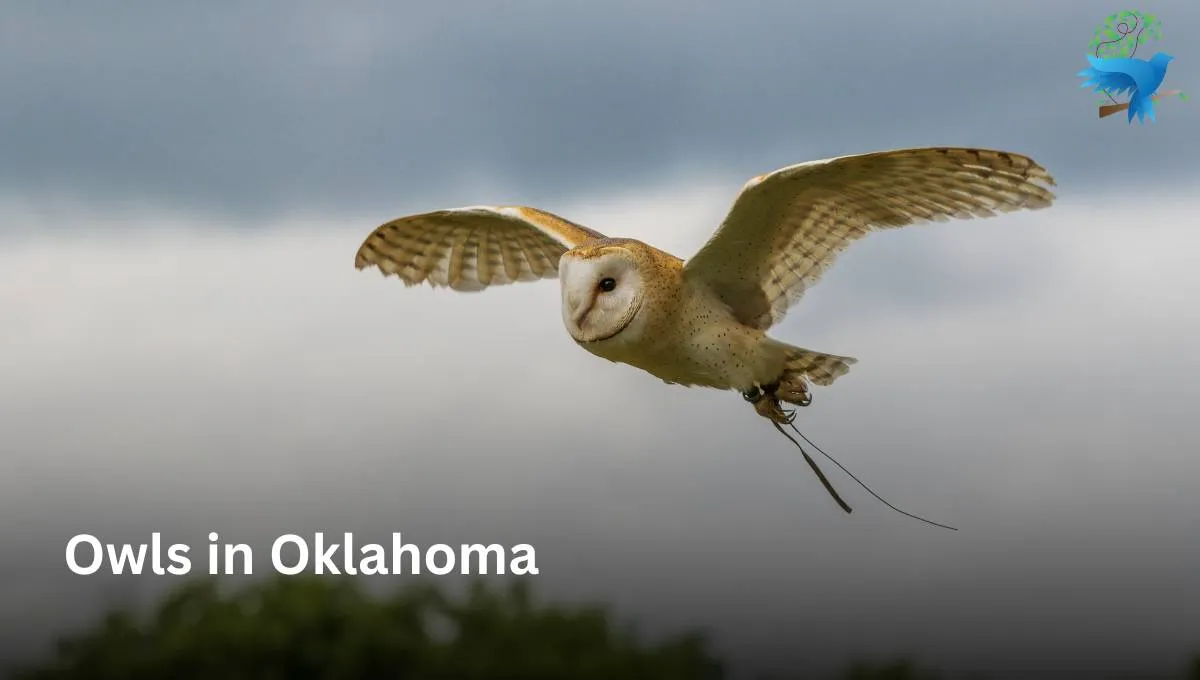
Oklahoma, located in the heartland of the United States, is renowned for its varied landscapes, rich cultural past, and wealth of wildlife.
Few exciting creatures living in its forests, plains, and cities are as iconic and mysterious as owls.
With their beautiful features, enigmatic nighttime habits, and quiet flight, owls have captured the human imagination for millennia.
Owls, whether flying across the night sky or perched atop tall trees, represent the state’s natural beauty and commitment to animal conservation.
In this blog, “Owls in Oklahoma,” we delve into the fascinating world of these birds of prey, studying their behaviors and habitats. So, stick to the end.
List of 5 Owls In Oklahoma
- Western Screech Owl
- American Barn Owl
- Short-eared Owl
- Burrowing Owl
- Northern Saw-whet Owl
1. Western Screech Owl
- Scientific name: Megascops Kennicottii
- Size: 19–25 centimeters (7.5–9.8 inches)
- Mass: 100–305 grams (3.5–10.8 oz)
- Wingspan: 55–62 centimeters (21.6–24.4 inches)
- Life Span: 1 to 8 years
Western Screech Owls are tiny owls with stocky bodies. They have a square skull, almost no neck, and prominent ear spikes. The tail is short.
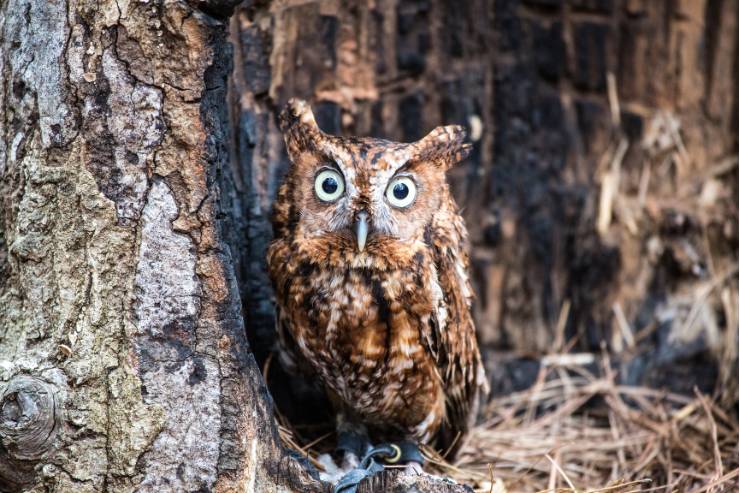
These species are excellent camouflage birds with a base color that might be grayish, brownish, or reddish-brown.
Camouflage: It is a defense or strategy that creatures adapt to blend in with the environment in which they live.
The top body is flecked with white. The face is dull and outlined with dark arcs. Their breast and belly are pale with dark, spidery lines, and their eyes are golden.
Western Screech Owls typically survive for one to eight years in the wild. The greatest record longevity for a western screech owl in the wild is 13 years, but in captivity, it is 19 years.
Habitat: Western Screech Owls live in various habitats in the West, including coastal forests in southeastern Alaska, cactus groves in the Arizona desert, and suburban areas.
They live in holes in trees, banks, or cliffs, not traditional nests. The tree species that occupy these hollows vary. Oaks, willows, cottonwoods, and cacti are among examples, but there are others.
Feeding: Western Screech Owls mainly hunt small mammals and giant insects. Their diet varies according to environment and area.
It also includes a variety of beetles, moths, other insects, scorpions, centipedes, spiders, and various small mammals, including voles, pocket gophers, and mice.
Furthermore, the Western Screech Owl eats tiny birds, snakes, lizards, fish, and frogs.
2. American Barn Owl
- Scientific name: Tyto Furcata
- Size: 32–40 centimeters (12.6–15.8 inches)
- Mass: 400–700 grams (14.1–24.7 oz)
- Wingspan: 100–125 centimeters (39.4–49.2 inches)
- Life Span: 2–4 years
The American barn owl is usually regarded as a subspecies group, and it, along with the western barn owl group, the eastern barn owl group, and sometimes the Andaman masked owl, form the barn owl, which has a worldwide range.
These species are often pale, with black eyes. American Barn owls’ heads, backs, and upper wings are a mix of buff and gray, and their faces, bodies, and underwings are all white. Barn owls have an average lifespan of two to four years.
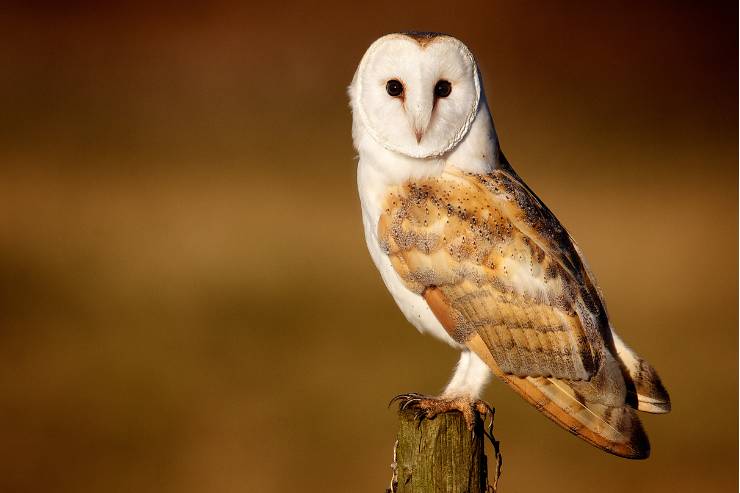
However, some have lived up to 34 years. Barn owls have an average lifespan of two to four years. However, some have lived up to 34 years.
Habitat: American Barn owls are cavity nesters. They build their nests in holes in trees, cliff ledges and crevices, caves, and many kinds of human structures, such as barn lofts, houses, church steeples, nest boxes, and haystacks.
Feeding: American Barn owls usually eat rodents. Voles are their primary prey, but they also eat mice, small rats, shrews, juvenile rabbits, and other mammals. These species also eat very few birds, lizards, insects, frogs, and fish.
Read More: 15 Yellow Birds With Black Wings to Discover >>>
3. Short-eared Owl
- Scientific name: Asio Flammeus
- Size: 34–43 centimeters (13.4–16.9 inches)
- Mass: 206–475 grams (7.3–16.8 oz)
- Wingspan: 85–103 centimeters (33.5–40.5 inches)
- Life Span: More than 12 years
- Conservation Status: Least Concern
The Strigidae family includes the short-eared owl, a typical grassland bird.
Owls in the genus Asio are known as eared owls because they have feather tufts that resemble mammalian ears.

Short-eared Owls are medium brown with buff and white markings on their upperparts.
The face is pallid, with bright eyes highlighted by black outlines.
The chest and tummy are light to buffy, whereas the breast is firmly stained with brown. Short-eared owls can survive for almost 12 years in the wild.
Habitat: They live on prairies, marshes, dunes, and tundra and are common in open country. They can be found in stubble fields, tiny meadows, coastal dunes, and shrubby places in winter.
Feeding: Voles are their primary prey, but they eat lemmings, deer, and pocket mice. Short-eared Owls consume shrews, rabbits, and gophers but rarely bats and muskrats. They often hunt birds, particularly in coastal areas.
4. Burrowing Owl
- Scientific name: Athene Cunicularia
- Size: 19–25 centimeters (7.5–9.8 inches)
- Mass: 150 grams (5.3 oz)
- Wingspan: 55 centimeters (21.6 inches)
- Life Span: 6 to 8 years
- Conservation Status: Least Concern
The burrowing owl, known as the Shoco, is a tiny, long-legged owl. It is small, with long legs and short tails.
The skull is rounded, with no ear tufts. Adults are brown birds with sandy-pale markings on their upperparts.
The breast is speckled, fading to dark brown bars on the belly, with a noticeable white neck, brows, and yellow eyes. The brown juveniles are less mottled than adults, with buffy-yellow underparts and a wing patch.
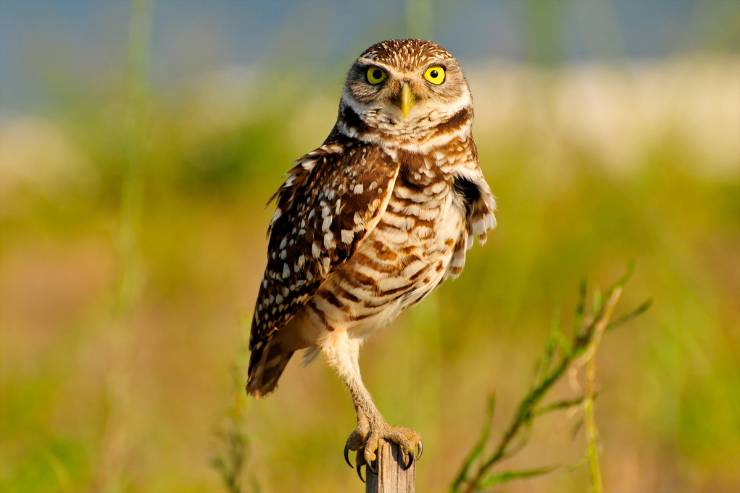
Burrowing owls reach sexual maturity after one year and usually survive six to eight years in the wild.
A burrowing owl has an average longevity of six to eight years, with the oldest recorded instance being at least nine and eleven months old after it was spotted in California in 2014.
Habitat: The burrowing owl is also one of Oklahoma’s most easily recognized owl species. It lives on golf courses, airports, pastures, agricultural areas, and deserted lots. Although draining wetlands harms numerous creatures, the burrowing owl’s habitat expands.
Feeding: The burrowing owl’s diet is mainly insect-based, but they will also eat snakes, frogs, tiny reptiles, birds, and rodents.
5. Northern Saw-whet Owl
- Scientific name: Aegolius acadicus
- Size: 18–21 centimeters (7.1–8.3 inches)
- Mass: 65–151 grams (2.3–5.3 oz)
- Wingspan: 42–48 centimeters (16.5–18.9 inches)
- Life Span: 16 years (in captivity) and (7 years in wild)
Northern saw-whet owl is a small owl species belonging to the Strigidae family. It is a mottled brown bird with a whitish facial disk and white-spotted head.
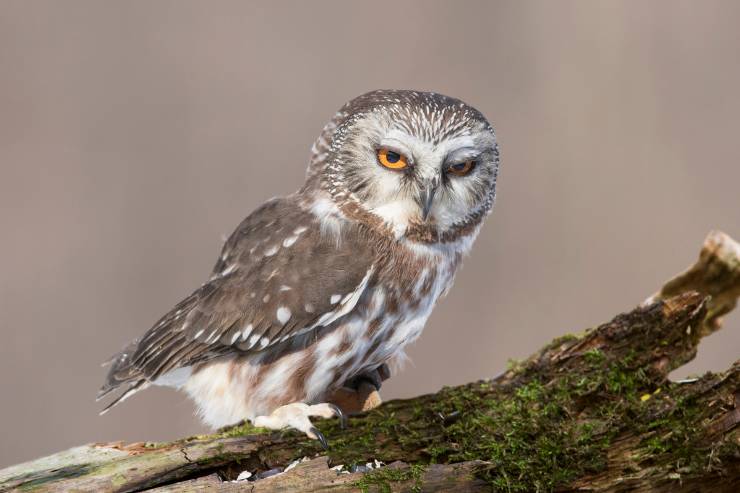
Its eyes are golden. Children’s northern saw-whet owls are dark brown, with a creamy yellow breast and belly.
They can live up to 16 years in captivity, but their maximum lifespan in the wild is seven years.
Habitat: They can be found in dense forests, usually at eye level, although they can even be found 20 feet up. The northern saw-whet owl migrates without following a precise schedule.
Feeding: These owls primarily consume tiny rodents. It mainly feeds on forest mice, particularly deer mice and many voles. They also eat other mice, shrews, young squirrels, and occasionally small birds and giant insects.
Conclusion
Finally, Oklahoma’s different environments provide a home for a surprising variety of owl species, each with its own features and adaptations.
From the secretive Western Screech Owl to the magnificent Barn Owl, the robust Burrowing Owl, and the elusive Northern Saw-whet Owl, these birds of prey exemplify the state’s dedication to wildlife conservation and preservation.
Understanding their behaviors, habitats, and ecological responsibilities will ensure that these iconic creatures are around for future generations to marvel at and admire.
Frequently Asked Question
What is the habitat of owls in Oklahoma?
Owls in Oklahoma inhabit diverse habitats ranging from wooded areas, including forests and riparian zones in the eastern part of the state, to grasslands, prairies, and agricultural lands in the west. They are also found in urban environments, nesting in parks, wooded lots, and even suburban neighborhoods, adapting to human presence.
What is the behavior of owls in Oklahoma?
Owls in Oklahoma exhibit a variety of behaviors that are tailored to their nighttime lifestyle and predatory instincts. They are primarily hunters at night who use sharp eyesight and acute hearing to detect prey such as rodents, insects, and small mammals.






